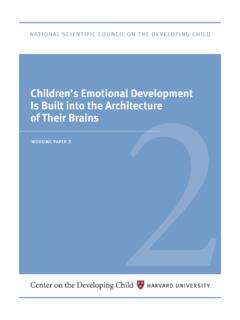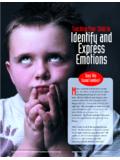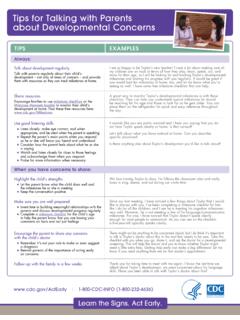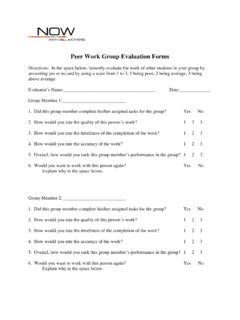Transcription of Enhancing and Practicing Executive Function Skills with ...
1 Enhancing and Practicing Executive Function Skills with Children from Infancy to 1 IntroductionExecutive Function and self-regulation Skills provide critical supports for learning and development. Just as an air traffic control system at a busy airport manages the arrivals and departures of many aircraft on multiple runways, Executive Function Skills allow us to retain and work with information in our brains, focus our attention, filter distractions, and switch mental gears. There are three basic dimensions of these Skills :n Working memory The ability to hold informa-tion in mind and use Inhibitory control The ability to master thoughts and impulses so as to resist tempta-tions, distractions, and habits, and to pause and think before Cognitive flexibility The capacity to switch gears and adjust to changing demands, priorities, or Skills help us remember the information we need to complete a task, filter distractions, resist inappropriate or non-productive impulses, and sustain attention during a particular activity.
2 We use them to set goals and plan ways to meet them, assess our progress along the way, and adjust the plan if necessary, while managing frustration so we don t act on it. Although we aren t born with Executive Function Skills , we are born with the potential to develop them. The process is a slow one that begins in infancy, continues into early adulthood, and is shaped by our experiences. Children build their Skills through engagement in meaningful social interactions and enjoyable activities that draw on self-regulatory Skills at increasingly demand-ing levels. AcknowledgementsThe Center on the Developing Child wishes to ex-tend deep thanks to Jocelyn Bowne for drafting this manuscript.
3 Thanks also go to Maia Barrow, Silvia Bunge, Deborah Leong, and Philip Zelazo for their thoughtful feedback and suggestions. Their expertise was invaluable in compiling these games and activities. Any errors or omis-sions are the sole responsibility of the Center on the Developing more resources on Executive Function from the Center on the De-veloping Child, please go to: infancy, interactions with adults help babies focus attention, build working memory, and manage reactions to stimulating experiences. Through creative play , games, and schoolwork, children practice integrating their attention, working memory, and self-control to support planning, flexible problem-solving, and sus-tained engagement.
4 By high school, students are expected to organize their time (largely) independently, keep track of their assignments, and manage projects to completion. As children develop these capacities, they need practice reflecting on their experiences, talking about what they are doing and why, monitoring their actions, considering possible next steps, and evaluating the effectiveness of their deci-sions. Adults play a critical role in supporting, or scaffolding, the development of these Skills , first by helping children complete challenging tasks, and then by gradually stepping back to let children manage the process independently and learn from their mistakes as they are ready and able to do activities that follow have been identified as age-appropriate ways to strengthen various components of Executive Function .
5 Although scientific studies have not yet proven the effec-tiveness of all these suggestions, their presence here reflects the judgment of experts in the field about activities that allow children to practice their Executive Function Skills . Practice leads to improvement. These activities are not the only ones that may help; rather, they represent a sample of the many things children enjoy that can support healthy development. Finally, please note that when websites and prod-ucts are referenced in these activity suggestions, it is because they are helpful resources or ex-amples. Their inclusion does not imply endorse-ment, nor does it imply that they are the only, or necessarily the best, 2 Executive Function Activities for 6- to 18-month-oldsLap games for younger infants Generations of families have engaged babies in games while holding them in the lap.
6 Differ-ent games practice different Skills , but all are predictable and include some basic rules that guide adult and child behavior. Repetition helps infants remember and manage their own behavior to fit the game s rules. n Peekaboo Hide-and-find games like this exercise working memory, because they chal-lenge the baby to remember who is hiding, and they also practice basic self-control Skills as, in some variations, the baby waits for the adult to reveal him or herself. In other versions, the baby controls the timing of the reveal; this pro-vides important practice regulating the tension around an expected surprise. n Trot, Trot to Boston; This is the Way the Farmer Rides; Pat-a-Cake Predictable rhymes that end with a stimulating yet ex-pected surprise are well-loved.
7 Infants exercise working memory as they develop familiarity with the rhyme and practice anticipating a surprise, inhibiting their anticipatory reactions while managing high levels of games Hiding games are a great way to challenge working memory. n Hide a toy under a cloth and encourage the infant to look for it. Once infants can find the toy quickly, hide it, show the child that you have moved it, and encourage the child to find it. Make more moves to increase the challenge. As the child remembers what was there and mentally tracks the move, he or she exercises working Older infants may enjoy hiding themselves and listening to you search loudly for them while they track your location mentally.
8 N You can also hide an object without showing an older infant where it is and then allow the infant to search for it. He or she will practice keeping track of searched locations. n Another challenging version of these games involves putting a set of cups on a turntable (or lazy Susan ), hiding an object under a cup, then spinning the turntable. Hiding more than one object can also increase the activities encourage infants to focus attention, use working memory, and practice basic self-control Skills . During this stage of development, infants are actively developing their core Executive Function and self-regulation (EF/SR) Skills .
9 Supportive, responsive interactions with adults are the foundation for the healthy development of these Skills . However, particular activities can strengthen key components of using these activities, adults should attend to the infant s interests and select activities that are enjoyable, while also allowing the infant to determine how long to play . 3 Imitation or copying games Infants love to copy adults. When they imi-tate, they have to keep track of your actions, remember them, wait their turn, and then recall what you did. In doing so, they practice atten-tion, working memory, and self-control. n These games have a variety of forms, from taking turns making simple gestures ( , waving) to organizing toys in certain ways and asking children to copy you ( , placing toy animals in a barnyard) or building simple build-ings by putting one block on top of another and perhaps knocking them down to rebuild.
10 N As infants Skills improve, make the patterns they copy more complicated. n Adults can also demonstrate ways to play with toys, like making a toy horse gallop or rocking a baby doll. This introduces the con-cept of using toys as symbols for real role playOlder children in this age range enjoy doing the tasks they see you do. n Take turns with any activity that interests the child, such as sweeping the floor, picking up toys, dusting, etc. These games introduce the basics of imaginary play and practice working memory, self-control, and selective attention, because the toddler must hold the activity in mind to complete it while avoiding distractions and inhibiting the impulse to do other Children can remember and play out more complicated roles as they get older.












